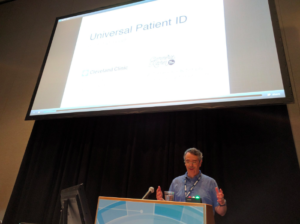DENVER, CO – Inaccurate patient identification is a severe problem for the US healthcare system. In 2014, the Office of the National Coordinator for Health IT found that the best error rate is approximately seven percent, meaning that seven out of 100 patient records are inaccurately matched. That error rate is closer to 10 to 20 percent within most healthcare systems, and can rise to 50 percent when those systems exchange information between one another.
Imagine attempting to deliver value-based care when your patient data points are invalid. The potentially dangerous consequences of this issue are disturbing. For example, one Sarah Smith might be highly allergic to penicillin, while another Sarah Smith is not. If patient data points are not matched with 100 percent accuracy, the first Sarah Smith could face serious complications.
This problem requires an airtight solution. Yet while many innovators are currently working to solve it, and though many organizations, including CHiME, are offering prizes to those who invent a workable solution, the issue of inaccurate patient data persists.
The Hackathon
At a recent Society for Imaging Informatics in Medicine (SIIM) hackathon, Commerce Kitchen, the Denver-based digital health consultancy and development studio, prototyped technology that could constitute an important step towards achieving accurate patient identification across disparate electronic medical record (EMR) systems.
SIIM represents the interests and goals of those who work with and whose work is affected by the rapidly changing world of imaging technologies and information management. At its annual meetings, the organization hosts its version of what is known as a “hackathon.”
Typically, hackathons are intensive two-to-three-day-long events where individuals and teams of diverse backgrounds rapidly develop a prototype in response to a challenge or within the parameters of some problem statement. While nothing new to the tech community, hackathons are becoming increasingly popular in healthcare, largely thanks to the digital health movement and the advent of the HL7 data standard FHIR.
The grand challenge of the 2016 SIIM Hackathon centered on “Enterprise Image Capturing and Viewing.” Six teams from around the country participated, including one from Johns Hopkins Medicine and another from the Cleveland Clinic. Commerce Kitchen was fortunate enough to participate remotely – which is rare – from Colorado.
The Prototype
The prototype developed by the Commerce Kitchen team tackled the primary upstream problem facing enterprise image capturing: patient identification.
As large hospital systems become more complex and distributed, the ability to share patient information between provider endpoints becomes increasingly complicated. The Commerce Kitchen team’s prototype demonstrated how two or more systems could correlate the appropriate data points and accurately confirm a patient’s identity without isolating any protected health information.
Using a sophisticated cryptographic algorithm, the prototype enables two disparate EMR systems to compare a handful of discrete data points in different patient records and yield either a match or a non-match, effectively permitting electronic assets like imaging results to be linked to the correct patient with a near 100 percent success rate. Simply put, this technology will allow for almost total certainty that Sarah Smith in hospital A and Sarah Smith in hospital B are indeed the same patient.
Due to the nature of Commerce Kitchen’s remote participation, the team was not able to present the idea in person at the project showcase. Dr. David Piraino, imaging informatics officer and staff physician at the Cleveland Clinic, presented the patient identification prototype on the team’s behalf to an enthusiastic assembly.
A Uniform Priority
Commerce Kitchen’s prototype was a step in the right direction. But to truly resolve this problem, diverse innovators and established healthcare experts alike will have to embrace the collaborative spirit that was on display at the 2016 SIIM Hackathon, working together to make accurate patient identification a uniform priority across healthcare coalitions.
Like the coverage that CyberMed News provides? Follow us on Twitter, LinkedIn, and Facebook to make sure you keep up to date on the most recent developments in digital health.






Be the first to comment on "Progress Towards Patient Identification at 2016 SIIM Hackathon"